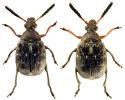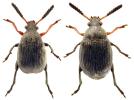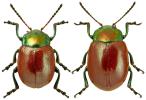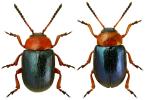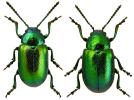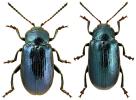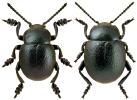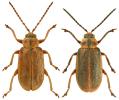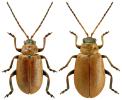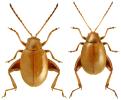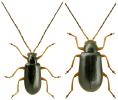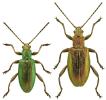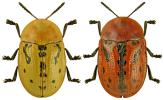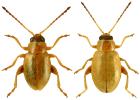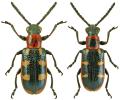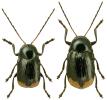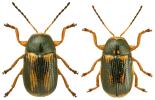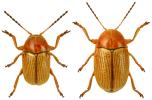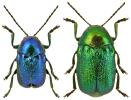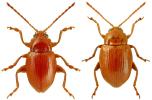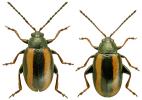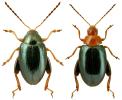Images:
A large and widespread family with 250 small to medium-sized British members (1-18mm). Beetles are usually oval or elongate-oval, brightly-coloured or metallic (or both), with filiform, threadlike antennae, and many species are relatively hostplant-specific. The family has undergone recent taxonomic changes, with species in Orsodacne and Zeugophora elevated to family (Orsodacniidae and Megalopodidae respectively) and the family Bruchidae incorporated into Chrysomelidae. Consequently there are now nine subfamilies.
Bruchinae contains 15 species known as seed beetles, pea weevils or bean weevils. They are small (2-5mm) oval brown-grey beetles, usually about as deep as they are wide, with truncate elytra revealing the pygidium and usually with pubescent elytra. The eyes are obviously notched, which differentiates them from the rest of the Chrysomelidae. Pollen-feeding adults can be found on white and yellow flowers and larvae develop within the seeds of Fabacaea, either in the field or in storage.
The reed beetles (Donaciinae) comprise 21 species in Britain. Usually brightly metallic, they are at first glance more similar to Cerambycidae than many other Chrysomelidae. Donacia and Plateumaris are widespread on reeds and other emergent marginal vegetation, while the two British species of Macroplea are aquatic, and are generally found submerged on pondweeds.
Criocerinae contains eight often brightly-coloured species, including the bright red garden pest Lilioceris lilii (Scopoli) (lily beetle) and the asparagus beetle Crioceris asparagi (L.). Generally elongate, with a narrow thorax compared to the elytra.
Cryptocephalinae has 24 British species, 20 of them in genus Cryptocephalus. As the name suggests, these have deflexed heads tucked underneath the pronotum and thus invisible when viewed from above. Generally brightly-coloured and metallic, many are local or very local, and only a few are common (Cryptocephalus labiatus (L.), C. aureolus Suffrian, C. pusillus Fabricius). Clytra laeviscula Ratzeburg and Cryptocephalus violaceus Laicharting are thought to be extinct in Britain, while Smaragdina affinis (Illiger) has not been recorded since 1965.
There is one species of subfamily Lamprosomatinae in Britain, the small (2-3mm), beetle Oomorphus concolor (Sturm). Widespread in broadleaf woodland across England and Wales, the species is black with a bronze irriescence, giving a brassy appearance and can often be found in ivy on tree-trunks.
Similarly, there is just one British species in subfamily Eumolphinae. The 5-6mm Bromius obscurus (L.) has been found in Cheshire on Epilobum spp. and is black, with orange basal antennal segments and yellow pubescence.
Chrysomelinae contains 43 British species. Generally brightly-coloured, often metallic beetles, they are largely hostplant-specific. The Colarado beetle, Leptinotarsa decimlineata Say is famed as a pest of potatoes but has never established in Britain, although the rosemary beetle Chrysolina americana (L.) is now established and widespread as a minor pest of rosemary and lavender. The group includes the bloody-nosed beetle Timarcha tenebricosa (Fabricius), which reflex-bleeds red fluids from the mouthparts when disturbed.
Subfamily Galerucinae is large, with 147 species recorded in Britain. The group is split into two tribes, generally of very different forms: the Galerucini, 20 species with simple femora, and the Alticini, 127 species with the hind femora modified and enlarged for jumping (hence their common name, the flea beetles). Most species are relatively hostplant-specific, feeding on leaves or roots.
Subfamily Cassidinae are the tortoise beetles, and there are 14 British species. Very distinctive in appearance, broad, extremely dorso-ventrally flattened and with the head completely hidden underneath the pronotum. Several species (particularly in genus Cassida) are green and well camouflaged on leaves, but a few such as Pilemostoma fastuosa (Schaller) or Cassida murraea L. are red and black. Hypocassida subferruginea (Schrank) is now thought to be extinct in Britain.

